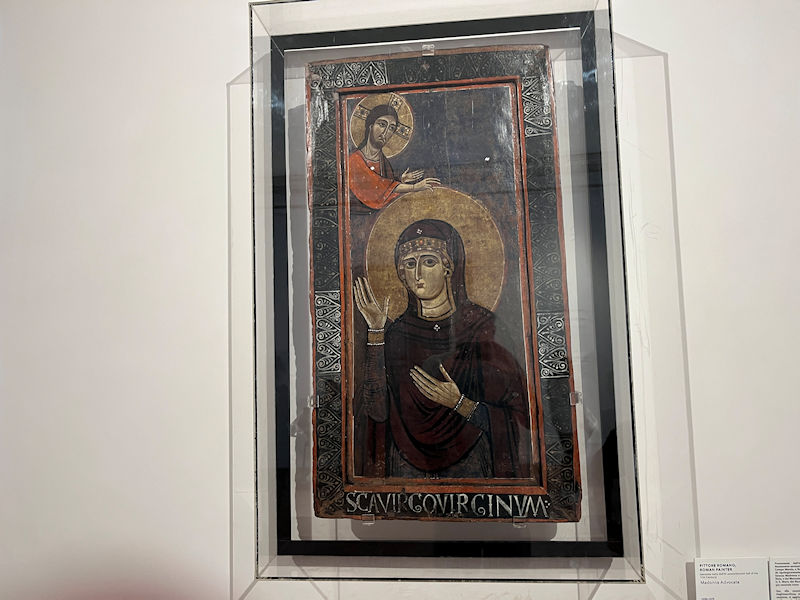You may not find this terribly rewarding unless you're included here, so this is a good time for casual and random browsers to turn back before they get too caught up in the sweep and majesty of the proceedings and can't let go.
We're off on a roundabout trek up to the Palazzo Barberini, one of the two hosts of the Gallerie Nazionali di Arte Antica (the other is the Palazzo Corsini, that's for tomorrow). 'Arte Antica' is taken to mean from about 1200 to the 18th century, with no classical antiquities. This is the Via Beatrice Cenci, leading to . . .

. . . the Piazza and 'Monte de Cenci'. The Cenci were minor nobility in the 16th century who lived in this area, along with a castle 60km northeast of Rome. Beatrice's father, the Count, was a vicious man who terrorized the family and repeatedly raped Beatrice as she was growing up. In 1598, the family finally drugged him and beat him to death, and staged it to look like an accident. It was found out, however, and Pope Clement VIII Aldobrandini resisted universal calls for judicial clemency on the grounds that it might encourage people to use violence against the nobility.

Beatrice, at the age of 22, and her stepmother were beheaded at the scaffold on the Sant'Angelo Bridge on 11 September 1599, and the pope distributed the family's properties amongst his own family members. Beatrice's case has become a legendary symbol of the people's resistance to the arrogant nobility and has been the source for centuries of plays, paintings, poems, operas, novels, and films. Caravaggio witnessed her execution, which is said possibly to have influenced his painting 'Judith Beheading Holofernes' (see below) at about that time.

A few blocks farther on, we passing through the old Jewish ghetto . . .

. . . not far from the Portico of Octavia and the Theatre of Marcellus.



The Portico d'Ottavia is at the end of the street.

A few blocks farther north, this is the Fontana delle Tartarughe, the Turtle Fountain, built in the 1580s, but the bronze turtles round the rim were added in ca.1658 by either Gian Lorenzo Bernini or Andrea Sacchi. Here's a better look at it, from two years ago.

We're stopping in the Italian Center for American Studies to see . . .

. . . the atrium with all the naked guys.

The Centre's been in the present building, the Palazzo Maffei (near the Turtle Fountain), since 1963 and growing, with a library of over 50,000 volumes.

Progress

The Piazza Venezia and the monument to Vittorio Emanuele II (1820–1878), the first King of Italy, built between 1885 and 1935. It includes the Altar of the Fatherland.

Looking northward towards the Church of Santa Maria of Loreto and the Church of the Most Holy Name of Maria at the Forum, with Trajan's Column alongside.

It's not for nothing that some people call that 'the Typewriter'.

Farther up the hill, just past the gardens of the Quirinale, we come to . . .

The Palazzo Barberini was commissioned by Pope Urban VIII Barberini and work began in 1625 by the architects Carlo Moderno, Gian Lorenzo Bernini, and Francesco Borromini, with decorative art throughout by Andrea Sacchi and Pietro da Cortona, and it was completed by Bernini in 1633. The palace with its gardens came into state ownership from the family heirs in 1949, and it was opened in 1953 as a second home for the Galleria Nazionali d'Arte Antica; it joined the existing Galleria Corsini, the palace and gardens of which were acquired by Pope Clement XII Corsini in 1736 and donated, which its collections, to the Italian state in 1883.

Round the side, a bridge over to the gardens, but . . .

. . . we'll enter through the front door.

The first thing to be noticed is Pietro da Cortona's much-appreciated fresco in the salon ceiling, the Baroque 'Allegory of Divine Providence and Barberini Power' [aka 'The Triumph of Divine Providence'], which to some of us might seem almost pointless without high-powered opera glasses and a lot of time in a cosy chair.

We begin with some interesting early works still with Byzantine overtones, this one called 'Madonna Advocata' by 'a Roman painter' of the late 11th century.

This is attributed to Niccolò di Bonaventura of Siena, ca. 1335-1340. Baby Jesus toying with his mother's veil was apparently a tradition in some quarters.

Newborn Jesus being presented in the Temple in Jerusalem, once part of some kind of altarpiece structure, is attributed to the Maestro di San Giovanni Evangelista, who worked in Bruges but frequently for Italian patrons, and dated to 1490-1495. Like many northern European works at the time, this is done with oil rather than tempera on panel.

-- Oh guys, have some dignity.

This odd little piece, the crucifixion with St Jerome and St Francis kneeling, is attributed to either Benvenuto di Giovanni or his son Girolamo of Siena, dated to 1490-1500.

'The Madonna adoring the Child with an Angel', designed for home use evidently, is by Gherardo di Giovanni di Miniato of Florence, and dated to 1480-1490. Baby Jesus either has got hold of a security blanket or he's nicked his mum's veil. It's in oil on panel.

The Annunciation: The Virgin with the angel Gabriel, presenting her with the lily of purity and virginity,
and two traumatized donors

This altarpiece is known as the Tarquinia Madonna (where it was located before being donated in 1944) by Filippo Lippi and dated to 1437. The information panel celebrates the interesting throne, the light coming through the window, and what not, but . .

. . . doesn't mention the awful fat, red face on Baby Jesus.
(This will be joining our collection of ugly baby Jesuses.)

'The Virgin and Child between St Peter and St Paul' (ca. 1498), by Vincenzo di Antonio Frediani of Lucca
(Peter's side-eyeing the Madonna, but what's Paul looking at?)
(Peter's got two keys; Heaven's got a side door?)

This is by Antoniazzo Romano, with whom we were reacquainted two days ago: the info panel points out that the artist has 'taken on board the novelties in northern European art' following the arrival in Florence in 1483 of wondrous triptych that the banker Tommaso Portinari had commissioned in Bruges. Especially notable is 'its meticulous depiction of nature'. It's 'The Nativity with St Lawrence and St Andrew', 1485-1490.
We can see St Lawrence's martyr-grid behind him (why isn't he looking at the baby?), but what about the other fellows? We should know this.

A small altarpiece by Lorenzo of Viterbo, 'Virgin and Child with St Michael [and his beheaded dragon] and St Peter', 1472. (The look of forbearance on Peter's face is priceless.)

Poor St Sebastian is normally festooned with arrows everywhere, but this is just a probably painful gut shot. But what is that goofus jailor with the rope trying to accomplish? St Catherine of Alexandria with her broken wheel and beheading sword looks pretty healthful, but with no intention of giving Sebastian much sympathy. This is attributed to Francesco Pagano of Naples, 1480-1490.
(In Parma a few years ago, we saw a St Sebastian with a single clean head shot.)

The 'Vision of the Blessed Amadeo Menez de Sylva', by Pedro Fernandez of Murcia, 1513-1514. The Archangel Gabriel points to the heavenly court for a Franciscan kneeling in prayer. The info panel describes Menez de Sylva (ca. 1320-1482) as 'an ascetic Spaniard who founded the Congregation of the Amadeites' for sterner observance of the rule than the other Franciscan orders.

-- Where everybody go?
-- I'm right here. See my thumb?
An info panel describes how the ground floor of the palazzo's north wing was designed to house the apartments of Pope Urban VIII's 2nd nephew Taddeo Barberini (1603-1647), the Prince of Palestrina. What a coincidence -- we just visited his Palazzo Barberini in Palestrina this time last year.
The Barberini were a minor noble family who settled in Florence in the 11th century, and throughout the 16th century became extremely successful merchants in Florence and then Rome. They were able to buy church offices and titles all over the shop, and in 1623 Cardinal Maffeo Barberini was elected as Pope Urban VIII, able to elevate his brother and two nephews as cardinals, another brother as a Duke, and another nephew, Taddeo, who married Anna Colonna in 1627, to call himself the 'Prince of Palestrina'. Way to go, boys.

We're heading upstairs to the piano nobile and some more recent good stuff.

-- Oi! Wait up!

Now that is a very cute Jesus. The future Pantocrator! No surprise, this is by Giulio Romano of Mantua, ca. 1517 (when he was 18), called the 'Hertz Madonna' as it came from Henrietta Hertz's collection in 1915.
Guido Pippi worked successfully in Rome, at first as an assistant to Raphael, but in 1522, at about 23 years old, Baldassare Castiglione was sent by the Gonzaga ruler of Mantua to entice him, and in late 1524 he moved to Mantua and never left. The locals there preferred to call him 'Romano' rather than 'Pippi', and it does sound better.

This picture of the Holy Family is by 'Perin del Vaga', originally from Florence, done in 1535-1540, and according to the info panel it is filled with traditional symbolism (cherries, apples, etc.). Most noticeably, perhaps, is the assertion that Christ's wrapping his mother's veil round his left hand prefigures the same way he'll someday be swathed in the Shroud. He certainly does look pretty unsettled about something.

There's a Madonna to conjure with (perhaps she wants this sitting to hurry up, she's got another posing job in half an hour). This is the 'Mystical Marriage of St Catherine with Sts Jerome, George, Sebastian, Anthony the Abbot, and Nicholas of Bari' (did we leave anybody out?), by Lorenzo Lotto, 1524. Jerome may be calling attention to the virtues of his translation of the scripture, whilst the newly mystical newlywed looks like a teenager with no idea what she's getting into; anyway she does seem already to have the ring on, so too late now. We note that old Nicholas and Anthony the Abbot are reading something interesting and can't be bothered, whilst martyrs Sebastian and George point out that passion for Christ can sometimes end really badly. Jesus has no idea what's going on but presents her with a flower anyway.

The Parcae 'represent the inevitability of human destiny' (oh wow, they look so young!). Clotho (right) presides over birth and spins the thread of life, Lachesis (left) winds red yarn on a spindle (why?). Atropos (centre) wields the scissors, whilst cherubs in front draw lots for the names to people to get whacked. 'The three Parcae' (1530-1540) by Marco Bigio of Sienna is apparently well-known, but it might be just a way to paint a classical theme featuring babes with their clothes off. The skeleton in the background is a nice touch.

Oh not another 'mystical marriage'. Catherine of Alexandria seems ready for it, though Mary has to hang onto her wrist. Baby Jesus looks a bit like he suspects that there's something wrong with this, whilst Catherine of Siena and the wasted looking St Bernardino of Siena hang about overhead. It is speculated that this was intended to be a tribute to Sulpizia (1489-1557) (same features as the 'bride'), the daughter of Pandolfo Petrucci, the tyrant of Siena and wife of Sigismondo Chigi, the Sienese ambassador in Rome. Anyway, it's by Girolamo Genga of Urbino, dated 1520-1530.

La Fornarina, Raphael's 1518-19 painting of the young woman, traditionally identified as Margherita Luti, the 'baker's daughter' = 'fornarina'), who may have been his lover and was certainly his subject in many of his paintings.

This is a classic, traditional portrait style of professional mercenary military men of the time, in this case in a 1546 portrait by Bronzino of the condottiero Stefano IV Colonna, a commander in the army of Cosimo I de' Medici, then the Duke of Florence and later the first Grand Duke of Tuscany. The subject, a descendant of the famously warlike Colonna clan, died in 1548.

We all know who that handsome chap is, in which Henry VIII is identified as in his 49th year, thus painted in about 1540. It's one of many portraits of the king and attributed to the Circle of Hans Holbein the Younger.
Not much good to say about this chap; maybe he made the trains run on time.

A much worthier subject for a portrait, Erasmus of Rotterdam (ca.1466-1536), the great humanist, philosopher, theologian, satirist, and translator, painted by Quentin Metsys in ca. 1517, apparently part of a diptych (with Pieter Gillis) sent as a gift to Thomas More.

Mary Magdalene, so often portrayed in art as a distraught penitent sinner, is here shown as a sophisticated and elegant worshipper, with the little jar of ointment that was one of her traditional accompaniments. This fine piece is by Piero di Cosimo of Florence, made in about 1495-1500. (She will join our collection of Mary Magdalene portraits.)

Vasari's 'Allegory of the Immaculate Conception' (ca. 1541), one of many copies, is a confusing pile-up of arcane symbolism. We can plainly see the Virgin's foot treading on the head of the serpent as sort-of-predicted in Genesis, and Adam and Eve appear at the bottom, but most of the rest of the participants escape a casual viewing. Vasari himself wrote about it in his Lives of the most eminent painters, etc.

This is a traditional approach to the Last Supper, disciples ranged round the table, the 'sleeping apostle' John the Evangelist, though it's more crowded than many treatments and with a darker background (in the tenebrist style) instead of landscapes out the window, but it's well done by Valentin de Boulogne in 1625-1626.
Wikipedia adds an interesting note to its article about the artist: 'Valentin de Boulogne is said to have died after bathing in the freezing cold waters of the Fontana del Tritone on Piazza Barberini, after having drunk too much'.

Our chief interest, however, has to do with what on earth they were eating (we keep a collection of Last Supper menus, and this is one of the most disgusting).

This rather suggestive picture represents 'Bathsheba in her Bath' (1573-1574) by Jacopo Zucchi, including all of the themes that would have interested Cardinal Ferdinando de' Medici, later to succeed as Grand Duke of Tuscany in 1587, for whom it was made. In keeping with the Bathsheba story from the OT book of Samuel, up on the far left King David can be seen peeping down on the ladies, which induced him to have her husband Uriah killed in battle, which angered God a lot.

Zucchi was the artist in residence to the Medici Grand Dukes of Tuscany, and apparently Cardinal and Grand Duke Ferdinando was so enraptured by Cielia Farnese, the illegitimate daughter of Cardinal Alessandro Farnese, Pope Paul III's nephew, and already married, that he had Zucchi make a number of portraits of her, this one in 1580-1585. Michel de Montaigne is said to have considered her, in one of his essays, the most beautiful woman in Rome.

This is a rather uninspired Judith and Holofernes by Jan Massijs or Matsys, unlike some of his funny Flemish-style domestic scenes, but since we have a collection of beheading pictures, chiefly to compare with Artemisia Gentileschi, Caravaggio, and other favorites, we'll include this coy mistress here.

The woman taken in adultery, from the gospel of John, by Tintoretto and his workshop, ca.1549

El Greco, of course: 'Adoration of the Shepherds' and 'Baptism of Christ', two small canvases in preparation for a large altarpiece commissioned by Augustinian nuns in Madrid in 1596.

'The Flute Player' presents an odd collection of people (and dogs) in a kind of harmonious tableau, but it's hard to figure out what it's all about. The info panel points out that the fact that the old gentleman is looking directly at us (and possibly offering that glass of wine), he might be inviting us to sort out some kind of allegory, possibly about the five senses (which seems implausible). It's by Bartolomeo Passerotti of Bologna, dated to 1585-1590.

This small altarpiece was commissioned in 1603 from Annibale Carracci by Cardinal Odoardo Farnese, a pieta with the deceased Christ, the Virgin Mary, St John, and St Mary Magdalene on the central panel, whilst the inner doors are said to represent St Cecilia on the left and St Hermenegild.
(Hermenegild was the son of a king of the Visigothic Kingdom in the Iberian Peninsula who revolted against his father in 580 and converted from Arianism to Roman-style Catholicism; he was defeated and exiled in 584 and died in 585, but with Pope Gregory I's backing this was celebrated as a martyrdom. His cult was especially urged by Philip II of Spain in 1585 and authorized for Spain by Pope Sixtus V.)

An intriguing Holy Family scene by Orazio Borgianni of Rome, showing influences of Caravaggio, made in 1609-1610 and including St Elizabeth, John the Baptist, and an angel (who's playing a violin for some reason).

An entry into the Fortune-teller category, this done in 1617 by the prolific Simon Vouet during his years in Rome -- the classic rustic young man is bewitched by the pretty fortune-teller whilst the old lady steals his purse.

'St Francis and the Angel', done in 1612-1613 by Orazio Gentileschi (Artemisia's dad), in which St Francis is shown, not in religious ecstasy as was common, but apparently while he's reliving the passion of Jesus.

'Narcissus', based more or less on Ovid's Metamorphoses but with this mysterious nocturnal setting. It's generally understood to be by Caravaggio in 1597-1599, but others go for Giovanni Antonio Galli (aka lo Spadarino), a Caravaggisti who would have been only 12-14 years old at that time, though he is apparently known to have been working in Rome then.

'St Francis in Meditation', also by Caravaggio and dated to 1606.

Caravaggio's contribution to the Judith Beheading Holofernes canon, done in about 1600. This is one of the best in the genre, but it's hard not to consider Artemisia Gentileschi's version to be the best one.

This is the Philistine Delilah preparing to snip off her boyfriend Samson's hair so that he'll lose his supernatural strength bestowed on him by God, dated to 1630-1631. It's by Matthias Stom or Stomer, a Dutch follower of the so-called Utrecht Caravaggists who after the age of about 30 spent the rest of his working life in Rome, Naples, and Palermo. We saw his brilliant Salome with John the Baptist's head some years agao in the Piazza Bianco in Genoa.
We're running out of space here now and still have some pretty amazing early 17th century pictures to record, so we'll stop here and resume on the next webpage.
Next up: The art gallery in the Palazzo Barberini (2) and the Villa Farnesina
 Dwight Peck's personal website
Dwight Peck's personal website









































































































